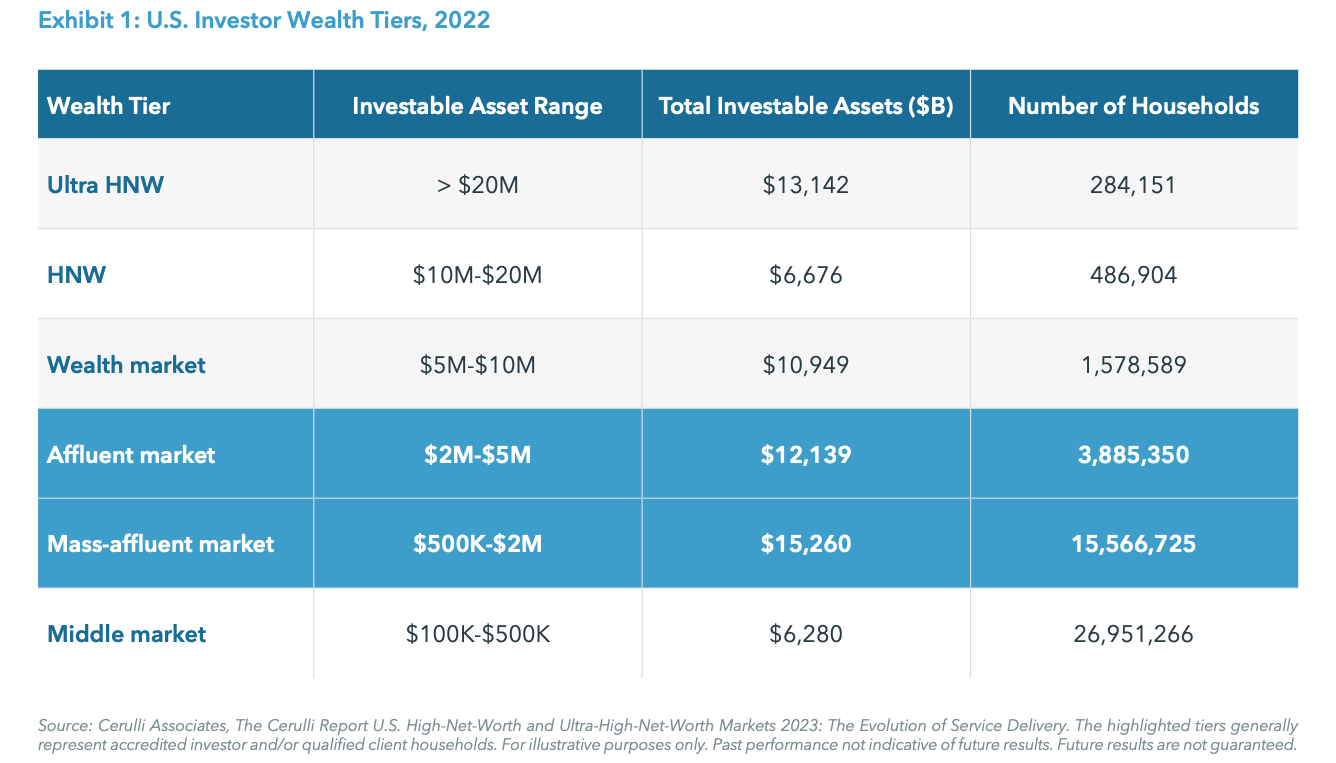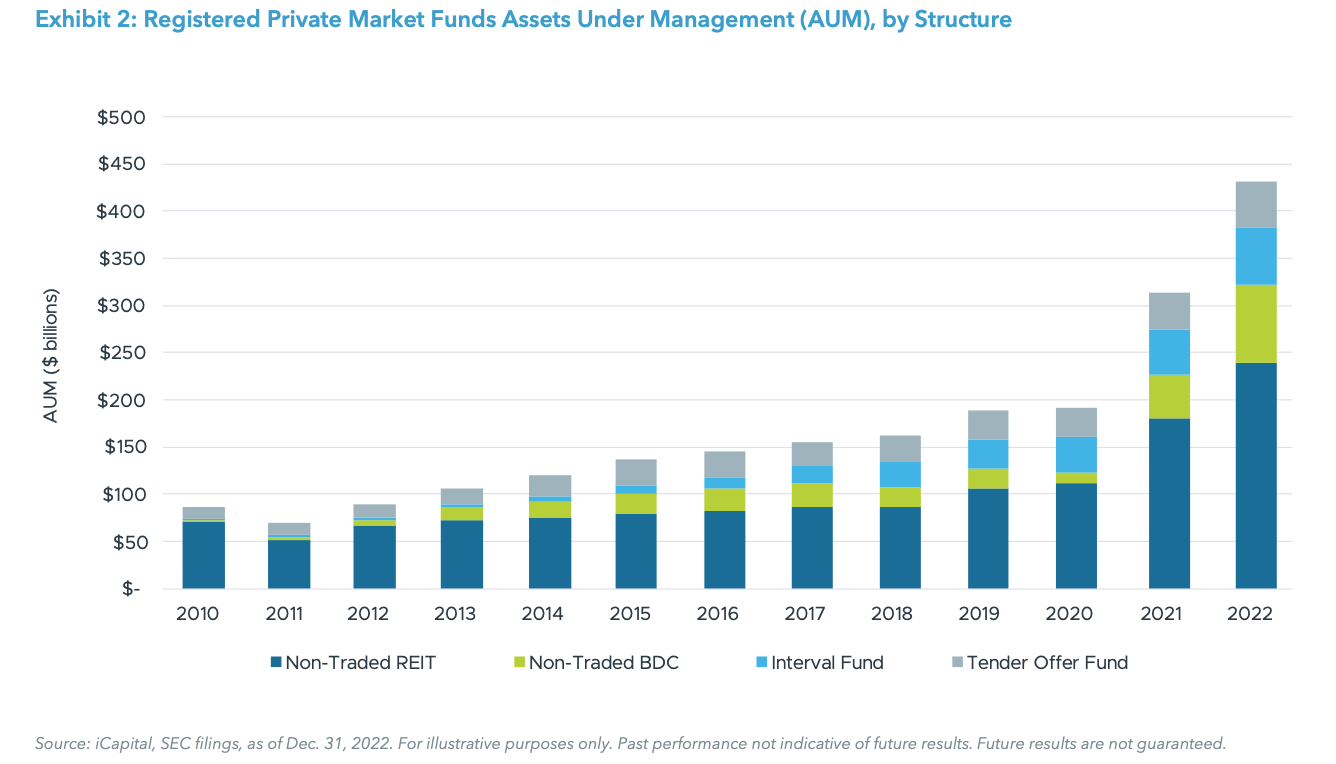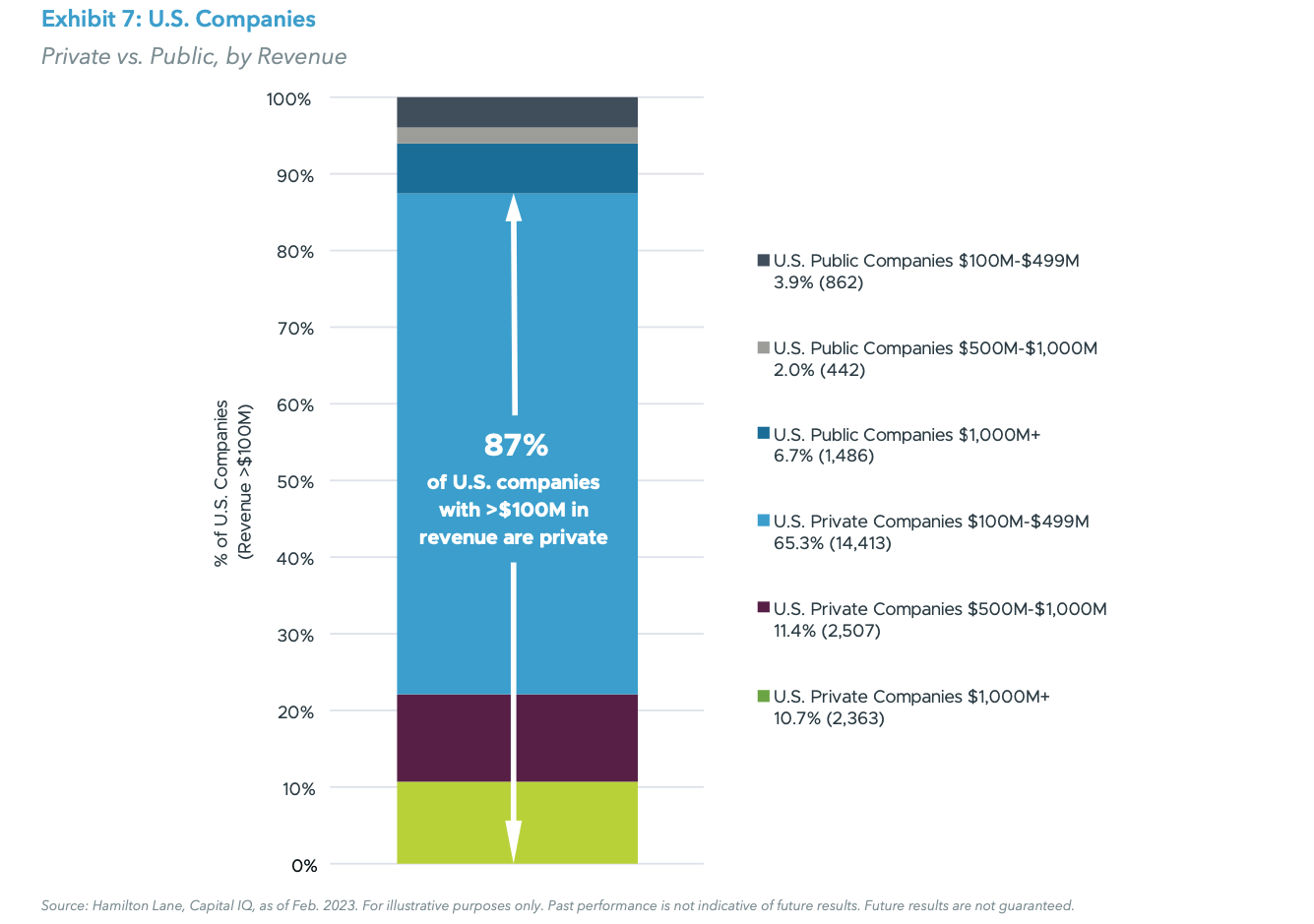Registered Private Market Funds – Transformation to Version 2.0
Over the past several years, the market for evergreen private market funds designed for individual investors,1 often referred to as “semi-liquid” funds, has evolved dramatically, narrowing the gap in both quality and cost relative to the investment options available to institutional investors.
As with the evolution of the mutual fund industry, the evolution of these individual investor-focused evergreen private market funds has had its share of stumbles. Ten to fifteen years ago, the first generation of these funds were often launched by smaller and less experienced managers. Moreover, many of these funds suffered from high front-end load fees, layers of management fees that were less aligned with shareholder capital, liquidity issues, improperly utilized leverage, and/or significant beta to public markets, masked by the notion of being “non-traded.”
In recent years, however, a growing number of large, established managers have entered the evergreen space, bringing with them more institutional-style pricing, structure, transparency, and education. As such, individual investors now have an ability to access private market return and diversification potential through numerous high-quality managers that were previously out of reach.
Historically, private equity investing has been largely limited to the very upper end of the wealth scale due to regulations which only permit qualified purchasers (QPs)2 to invest directly into traditional, closed-end drawdown funds. These closed-end investment vehicles generally have a fixed term of 10 years and come with the complexities of a J-curve (capital calls and distributions). High investment minimums and operational hurdles also created barriers to the accredited investor (AI)3 market, which represents an estimated $27 trillion across approximately over 19 million households, excluding QPs (Exhibit 1).4 Yet, as private market allocations within the institutional channel (e.g., pension funds and endowments) have begun to plateau, many established managers have made tapping into the $60 trillion U.S. wealth channel5 a top priority. Today, a new generation of evergreen funds, or flexible investment vehicles which allow investors to enter and exit the fund on a periodic basis, are transforming the market, with established managers leveraging technology and employing teams of dedicated product specialists to educate wealth advisors and their clients.
In fact, almost every large-scale alternative asset manager has now entered the race to bring alternatives to a broader set of investors. Key players include “household” name general partners (GPs) like Apollo, Ares, Blackstone, Blue Owl, Carlyle, and KKR, as well as major traditional long-only managers such as BlackRock, Franklin Templeton, Nuveen, and PIMCO. In addition, most of the leading private markets specialists that focus on secondaries and syndicated direct co-investments have launched tender offer funds under the Investment Company Act of 1940 (the ’40 Act), including Hamilton Lane, Neuberger, Pantheon, Portfolio Advisors, StepStone. Partners Group, the pioneer in the registered fund space with 30% of their AUM currently in evergreen structures, is anticipated to launch six new evergreen solutions to expand their reach in the private wealth channel.6 All of these managers want to control the quality of their products, protect the integrity of their brands, and develop direct relationships with global private wealth platforms and independent wealth firms.
Today’s managers are addressing liquidity in the context of holding private investments in registered funds. Thoughtful portfolio construction has enabled managers to more closely align liquidity terms with the underlying investments’ anticipated liquidity needs. In addition, in many cases, the management fees have come down to closer to institutional- style pricing and, in some cases, the incentive fees (or profit participation) that the managers charge have also come down to levels once reserved only for institutional investors. Furthermore, the egregious front-end loads, which averaged 7% over a decade ago, have been cut in half and, oftentimes, are waived entirely by advisors today.
The ability to invest capital with well-known, established managers into structures that are not only competitively priced but that also deploy the capital quickly has been a game changer for many investors. These structures deliver instant exposure to seasoned portfolios of private investments with compounding returns, compared to traditional closed-end funds in which the committed capital is drawn down over several years. In fact, some of these funds have been attracting the interest of institutional investors and, more recently, GPs have been designing evergreen funds focused specifically on institutions.
As a result, the aggregate assets under management (AUM) of evergreen funds focused on private capital has more than quadrupled to $430 billion over the past 10 years.7 In particular, two major asset classes have driven this rapid AUM growth: real estate, through non- traded REITS, and private credit, through both non- traded BDCs and interval funds (Exhibit 2). Sustained low interest rates from 2015 to the beginning of 2022 certainly helped propel these products, which offered individual investors higher yields and current income at a time when the fixed income side of the traditional 60/40 portfolio was struggling.
Private Equity Designed for Individual Investors
While private equity has been slower to evolve in the evergreen, “semi-liquid” space, it is now beginning to scale as numerous high-quality private market specialists have launched registered funds in recent years, and a number of large private equity firms have designed innovative structures for individual investors. Exactly how this is happening is worth understanding better.
Registered Private Equity Tender Offer Funds
Tender offer funds are SEC-registered and continuously accept new subscriptions from eligible investors. The evergreen structure is designed to provide shareholders with consistent private equity exposure through a single investment. Minimum investments can be as low as $25,000 and the individual investor is not subject to any capital calls throughout the life of the investment – in other words, the money goes to work immediately into an existing portfolio of private investments. In addition, tax reporting is provided through a Form 1099, rather than the more complicated Schedule K-1 typically associated with private equity.
While tender offer funds provide for more liquidity than traditional private equity funds, they are still intended to be longer term investments. Periodic tender offers, which are usually quarterly at 5% of net asset value (NAV), are conducted at the discretion of the fund’s board of directors and may be suspended at any time without shareholder approval (i.e., in a steep market decline, the managers of these funds may suspend redemptions to avoid a “fire sale” of private assets).
With the emergence of ‘40 Act registered tender offer funds, major wealth management platforms can now provide continual private equity exposure to their accredited investors and qualified clients (QC)9 in addition to their QP clients, who want to see their money put to work immediately and remain invested. In fact, almost every major private bank is now offering private equity in an evergreen structure, in addition to many RIA firms and independent broker dealers.
On the supply side, numerous established private market specialists are taking advantage of free (or low fee) co-investment deal flow generated by their primary commitments to private equity funds. This enables them to provide their registered funds with access to private equity deals led by quality GPs at low underlying “acquired fund fees,” which typically brings the all-in cost to a range of 250- 400 basis points on the NAV.10 Hamilton Lane, for example, is able to leverage access to quality syndicated co- investments in its Private Assets Fund (PAF), a continuously offered, multi-manager, sector-diverse ‘40 Act registered vehicle. PAF is a private equity offering with a focus on direct equity investments and secondaries. PAF seeks to deliver medium and long-term capital appreciation, while offering quarterly limited liquidity to investors.11
Separately, iCapital has worked closely with three major private equity firms (KKR, Vista Equity Partners, and Warburg Pincus) to provide direct access to almost all their private equity deals through a registered fund called the iDirect Private Markets Fund. This structure charges a low underlying “acquired fund fee” based on NAV, as opposed to a percentage of committed capital, which is how traditional private equity funds have historically charged management fees. This enables the all-in costs for this evergreen fund to more closely resemble institutional- style pricing.12 For full disclosure, the independent advisor of this tender offer fund is a subsidiary of iCapital.
With these pricing developments, the costs for numerous evergreen funds focused on private equity are becoming more competitive with 3(c)(7) feeder funds that are only available to QPs. When combined with the presence of high-quality managers, lower investment minimums, and the ability for investors to become fully invested on day one, it is not surprising that the adoption of tender offer funds by the private wealth channel has begun to accelerate over the past three years.
Non-Registered Evergreen Private Equity Funds/Structures
The latest development in the private equity asset class is the launch of non-registered funds in an evergreen format by some of the industry’s largest GPs. Apollo has launched an open-ended 3(c)(7) fund in the form of a limited partnership, which provides access to a blend of private equity, real assets and private credit. While this fund is restricted to QPs, it is designed with the individual investor in mind, potentially serving a couple different roles in client portfolios – either as the core of a mature, diversified private market allocation or as a replacement for a traditional public equity allocation.13 Blackstone also recently launched an evergreen 3(c) (7) fund focused on private equity. Their fund, which went live in January 2024, is also restricted to qualified purchasers, with monthly, fully funded subscriptions and periodic repurchase offers.14 KKR has launched perhaps the most groundbreaking vehicle in the form of a conglomerate or operating company structure that owns and operates businesses alongside KKR private equity strategies and is available to accredited investors.15 The first-of-its-kind structure provides direct access to a diversified, fully drawn portfolio of KKR private and growth equity portfolio companies owned and operated across the globe. We should note that private equity firms are generally prohibited by the SEC from creating and managing their own registered private equity funds, which is why these major players have come up with these evergreen vehicles and why the iDirect Private Markets Fund exists.
In the race to capture the massive wealth market and diversify their investor bases beyond institutional capital, these firms are taking bold steps and ramping their resources to educate wealth advisors and explain the benefits and streamlined structures of these new products.
Why This Matters
For advisors and clients seeking to diversify risk exposure away from public equity, private equity may offer better long-term return prospects. Private equity has outperformed the S&P 500 by over 500 basis points over the last 20 years, and with significantly lower volatility than public markets (Exhibit 5).16 That historical return profile could be especially beneficial in an environment where many expect continued volatility and lower returns from public equity.
Private equity also provides investors with access to a larger universe of investment opportunities compared to public equity. Over the past 25 years, the number of U.S. private companies has gradually increased while the number of publicly listed companies continues to shrink, declining by nearly 50% since 1996, from approximately 8,090 to 4,266 in 2019 (Exhibit 6).17 This shrinking universe of public companies has also grown older with less growth. One study found that the average age of a newly listed company in the technology sector rose from five years old in 2000 to 15 years old in 2022.18
Today, there are more than 19,000 private companies in the U.S. with annual revenues above $100 million, compared to just 2,800 public companies (Exhibit 7).19 This speaks to the elongation of the private company life cycle – as more and more private companies stay private longer, the number of private companies with multi-billion-dollar valuations has reached unprecedented levels.
The ability to think and act with a long-term perspective is one of private equity’s biggest advantages over public equity. Private equity professionals spend far more time discussing strategy and long-term value creation with their management teams than board members of public companies, which are often afflicted by short-termism. The management teams can operate their companies without the pressure to meet short- term analyst expectations and can instead focus on their long- term objectives. Finally, the economic interests of the GPs are highly aligned with those of their investors through meaningful personal commitments and profit-based incentives.
While investors tend to be conservative when considering illiquid assets, a BlackRock study found that an investor’s ability to take on liquidity risk may be higher than is typically assumed, depending on spending needs.20 The study concluded that institutional investors with high spending needs – up to 8% of the portfolio – can sustainably manage allocations up to 20% in private investments.21 For advisors and clients following the “4% Rule” – which is generally regarded as a conservative annual spending rate – reallocating 5-10% of a total portfolio to private equity should have a negligible impact on overall liquidity, while enhancing diversification and increasing return potential.
A Fundamental Shift is Underway
With more individual investors seeking uncorrelated sources of return to help mitigate risk in a traditional stock/bond portfolio, the next wave of evergreen private market funds is a welcome innovation. In iCapital’s 2023 Financial Advisor Survey, 95% of participating U.S. financial advisers said they plan to maintain or increase allocations to alternative investments in the coming year, with 44% actively planning to increase their allocations.22
Their timing looks good as it relates to the breadth of products they have to choose from today – which is being driven by a growing urgency among established private equity firms to build their brands in the massive U.S. wealth channel. While some may question why top-tier private fund managers are pursuing individual investor capital, the latest structures and aggressive pricing of these version 2.0 evergreen private market funds show just how committed these GPs are to the wealth management channel. With so many established, proven managers now fully committed to this market, the trend towards even lower costs and broader access will only continue.
ENDNOTES
1. For purposes of this paper, “individual investors” refer to individuals or entities who do not meet the criteria to be classified as a qualified purchaser. These investors generally need to meet the accredited investor and/or qualified client criteria in order to invest in a registered private market fund.
2. A qualified purchaser is generally defined as an individual with at least $5 million of investable assets, or an entity with $25 million of investable assets. For the full definition, please see Section 2(a)(51) of the Investment Company Act of 1940.
3. An accredited investor is generally defined as an individual with a net worth of at least $1 million, either individually or jointly with their spouse, excluding the value of their primary residence, or annual income exceeding $200,000, or $300,000 for joint income, for the last two years with expectation of earning the same or higher income in the current year. For the full definition, please see Rule 501(a) of Regulation D under the Securities Act of 1933.
4. Cerulli Associates, The Cerulli Report U.S. High-Net-Worth and Ultra-High-Net-Worth Markets 2022: Shifts in Alternative Allocations.
5. Cerulli Associates, The Cerulli Report U.S. High-Net-Worth and Ultra-High-Net-Worth Markets 2022: Shifts in Alternative Allocations.
6. iCapital, SEC filings, as of Dec. 31, 2022.
7. iCapital, SEC filings, as of Dec. 31, 2022.
8. The SEC defines a 3(c)(7) fund as a pooled investment vehicle that is excluded from the definition of investment company in the Investment Company Act because it is limited to investors that are qualified purchasers and otherwise meets criteria outlined in Section 3(c)(7) of the Investment Company Act.
9. A qualified client is generally defined as an individual with a net worth of at least $2.2 million, either individually or jointly with their spouse, excluding the value of their primary residence, or at least $1.1 million under the management of the investment advisor immediately after entering into an investment advisory contract. For the full definition, please see Rule 205-3 of the Investment Advisers Act of 1940.
10. All-in cost for the institutional share class include the management fee, expenses, incentive fees (where applicable), and underlying acquired fund fees. The all-in-cost for other share classes may be higher.
11. Hamilton Lane Private Assets Fund (PAF), as of Nov. 15, 2023. For more information, please see the Hamilton Lane Private Assets Fund website.
12. iDirect Private Markets Fund (iDPE), as of Nov. 7, 2023. For more information, please see the iDirect Private Markets Fund website.
13. Apollo Global Management, Inc., Q2 2022 Earnings Call, Aug. 4, 2022.
14. SEC, Blackstone Private Equity Strategies Fund L.P. 10-Q: Quarterly report for quarter ending Sept. 30, 2023, Nov. 9, 2023. For more information, please see the Blackstone Private Equity Strategies Fund website.
15. KKR Private Equity Conglomerate LLC (K-PEC), as of Nov. 15, 2023. For more information, please see the KKR Private Equity Conglomerate LLC website.
16. Partners Group, Interim Financial Results 2023, as of June 20, 2023.
17. PitchBook, Bloomberg, iCapital Investment Strategy, as of Nov. 8, 2023. Note: All return data is as of March 31, 2023.
18. The World Bank, as of May 10, 2023.
19. University of Florida, Warrington College of Business, Initial Public Offerings: Updated Statistics, as of May 23, 2023.
20. Hamilton Lane, Capital IQ, as of February 2023.
21. Blackrock Investment Institute, The Core Role of Private Markets in Modern Portfolios, March 2019.
22. Blackrock Investment Institute, The Core Role of Private Markets in Modern Portfolios, March 2019.
23. iCapital, 2023 iCapital Financial Advisor Survey, Aug. 17, 2023.
IMPORTANT INFORMATION
The material herein has been provided to you for informational purposes only by Institutional Capital Network, Inc. (“iCapital Network”) or one of its affiliates (iCapital Network together with its affiliates, “iCapital”). This material is the property of iCapital and may not be shared without the written permission of iCapital. No part of this material may be reproduced in any form, or referred to in any other publication, without express written permission of iCapital.
This material is provided for informational purposes only and is not intended as, and may not be relied on in any manner as, legal, tax or investment advice, a recommendation, or as an offer or solicitation to buy or sell any security, financial product or instrument, or otherwise to participate in any particular trading strategy. This material does not intend to address the financial objectives, situation, or specific needs of any individual investor. You should consult your personal accounting, tax and legal advisors to understand the implications of any investment specific to your personal financial situation.
ALTERNATIVE INVESTMENTS ARE CONSIDERED COMPLEX PRODUCTS AND MAY NOT BE SUITABLE FOR ALL INVESTORS. Prospective investors should be aware that an investment in an alternative investment is speculative and involves a high degree of risk. Alternative Investments often engage in leveraging and other speculative investment practices that may increase the risk of investment loss; can be highly illiquid; may not be required to provide periodic pricing or valuation information to investors; may involve complex tax structures and delays in distributing important tax information; are not subject to the same regulatory requirements as mutual funds; and often charge high fees. There is no guarantee that an alternative investment will implement its investment strategy and/ or achieve its objectives, generate profits, or avoid loss. An investment should only be considered by sophisticated investors who can afford to lose all or a substantial amount of their investment.
iCapital Markets LLC operates a platform that makes available financial products to financial professionals. In operating this platform, iCapital Markets LLC generally earns revenue based on the volume of transactions that take place in these products and would benefit by an increase in sales for these products.
The information contained herein is an opinion only, as of the date indicated, and should not be relied upon as the only important information available. Any prediction, projection or forecast on the economy, stock market, bond market or the economic trends of the markets is not necessarily indicative of the future or likely performance. The information contained herein is subject to change, incomplete, and may include information and/or data obtained from third party sources that iCapital believes, but does not guarantee, to be accurate. iCapital considers this third-party data reliable, but does not represent that it is accurate, complete and/or up to date, and it should not be relied on as such. iCapital makes no representation as to the accuracy or completeness of this material and accepts no liability for losses arising from the use of the material presented. No representation or warranty is made by iCapital as to the reasonableness or completeness of such forward-looking statements or to any other financial information contained herein.
Securities products and services are offered by iCapital Markets, an SEC- registered broker-dealer, member FINRA and SIPC, and an affiliate of iCapital, Inc. and Institutional Capital Network, Inc. These registrations and memberships in no way imply that the SEC, FINRA, or SIPC have endorsed any of the entities, products, or services discussed herein. Annuities and insurance services are provided by iCapital Annuities and Insurance Services LLC, an affiliate of iCapital, Inc. “iCapital” and “iCapital Network” are registered trademarks of Institutional Capital Network, Inc. Additional information is available upon request.
© 2024 Institutional Capital Network, Inc. All Rights Reserved. | 2024.01.


























